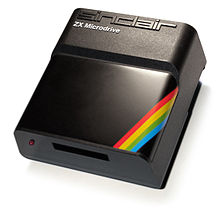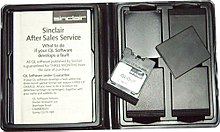Microdrive (tape drive)

The ZX Microdrive is a tape device for the magnetic mass storage of data, which was launched by Sinclair Research in July 1983 for the ZX Spectrum home computer and was touted as a cheaper alternative to floppy disk drives . The Microdrive stores the data on individual exchangeable data carriers (approx. 5 cm × 3.5 cm × 0.5 cm), which are plugged into the Microdrive like a plug- in module . In the data carrier, comparable to the 8-track cassette , there is a chromium dioxide tape connected in an endless loop , half as wide as that in the audio compact cassettes popular at the time . A complete run of the belt takes 7.5 seconds. Each data carrier has a storage capacity of 100 KB at a transfer rate of 16 KB per second. Because of the running noise and the unusual design, this strap was often referred to in the jargon as a “raging shoelace”. The stringy floppy for the TRS-80 worked on a similar principle.
In the drive, only a mechanically modified stereo head (for tape guidance) is used to read and write the data. The miniaturization of the mechanical parts leads to rapid wear and tear, and the special cassette quickly becomes unreliable and ultimately unusable. The individual data carriers were comparatively expensive. The ZX Microdrive requires the so-called ZX Interface 1 as a controller for connection to the ZX Spectrum . This extension, which also offers serial interfaces and a rudimentary network functionality, was mostly sold together with the actual Microdrive.
Microdrive technology was later used for the Sinclair QL computer. The main developer of the Microdrive was Ben Cheese . The Microdrives themselves were subject to the following further development:
- The ZX Spectrum and the cassette drives common in home computers at the time support the sequential storage common to tape drives. The QL, on the other hand, saves exactly the division into sectors with net 512 bytes, a dynamic, flexible file directory and a so-called sector map comparable to the DOS cluster table (the Microdrive format uses one sector per cluster, the otherwise identical format on the QL floppy disks with 720 KB uses three sectors per cluster).
- Because of this difference between the different controllers installed externally, 85 kB (spectrum) or about 110 kB (QL) are stored on a data carrier.
- During formatting, defective sectors are recognized by the QL and automatically removed from circulation by an entry in the sector map .
- In contrast to the FAT system in MS-DOS, the root directory does not have a fixed, but a variable length.
- The data in the sector map are optimized for special tricks of the QL operating system: In contrast to MSDOS computers, in the case of a larger read job, every cluster that is just passing the read head that belongs to this job is immediately read in in any order and appropriately inserted in the main memory . In this way, even a fragmented file can be read in by the Microdrive in no more than a single belt loop run (around 7.5 seconds). Spectrum and QL do not support defragmentation.
Individual evidence
- ↑ Tony Smith: Infinite loop: the Sinclair ZX Microdrive story - The rise and fall of a 'revolutionary' storage technology. theregister.co.uk, March 13, 2013
- ^ Sinclair ZX Spectrum. Entry at classiccomputer.de, accessed on March 9, 2014
Web links
- English page with additional information about the Microdrive
- To the development of the ZX Microdrive
- Detailed article on the development of the Microdrives and their intricacies on TheRegister.co.uk


